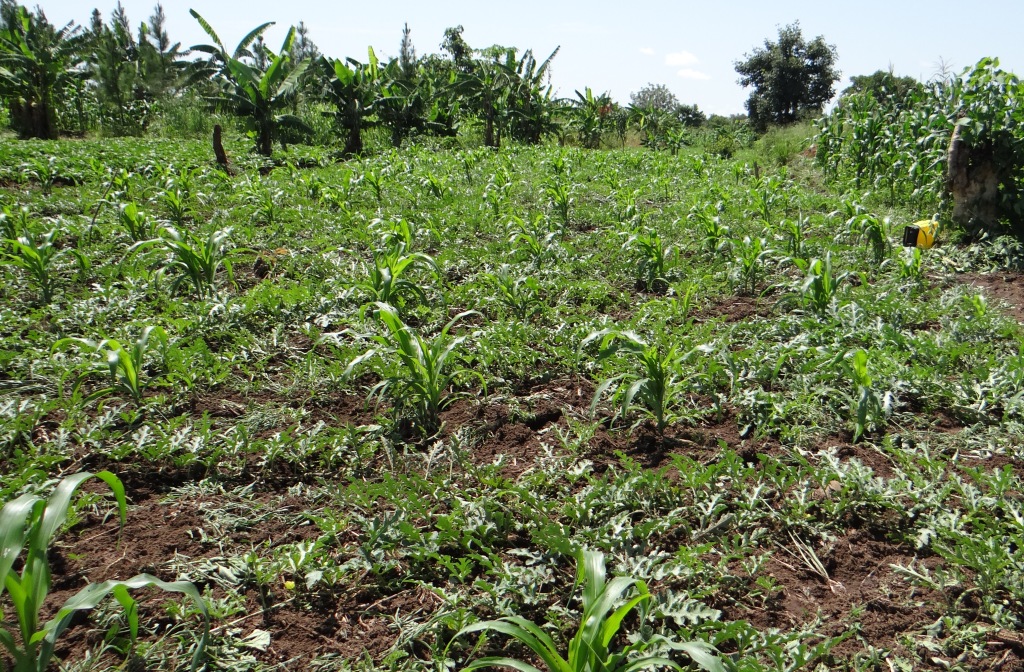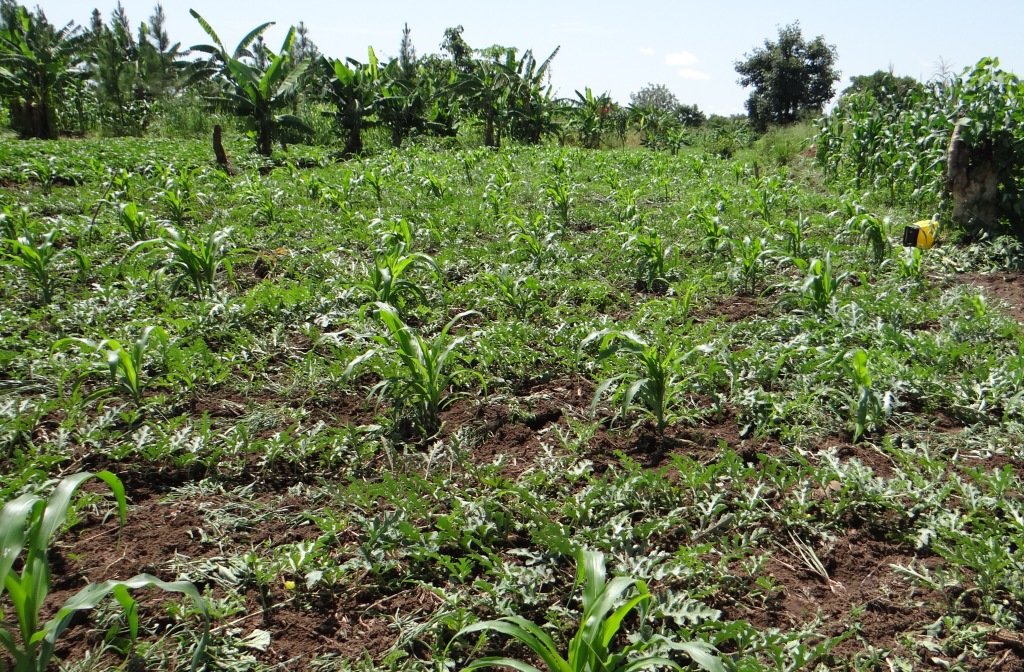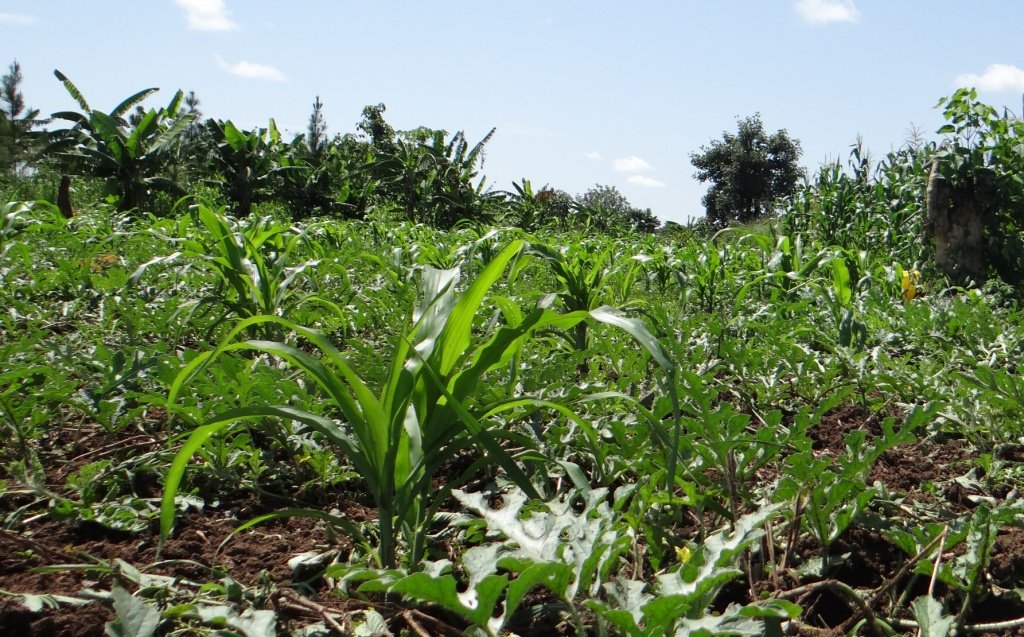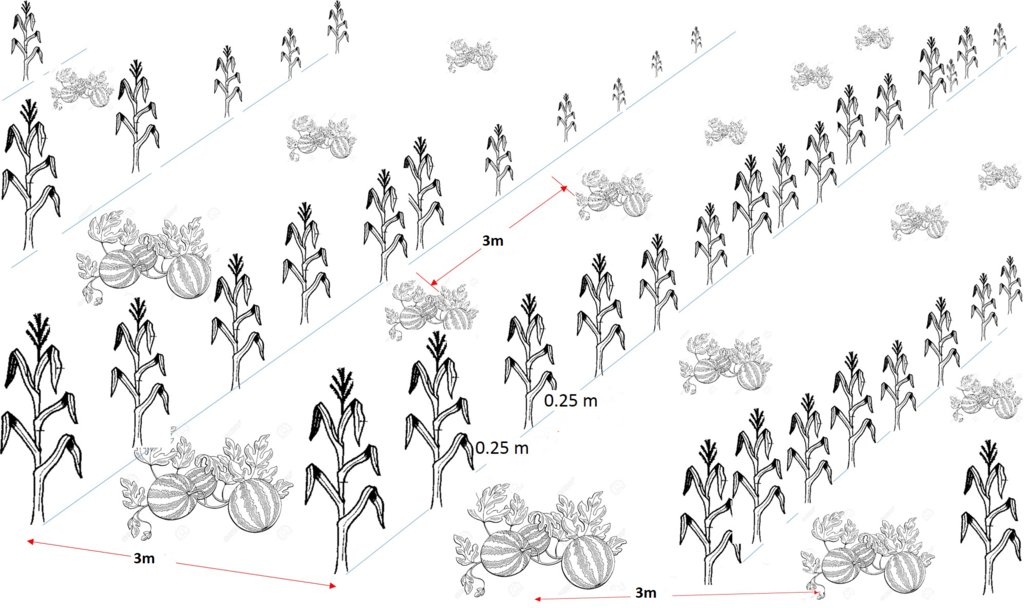Optimizing Land-Use Through Maize-Watermelon Intercropping [Uganda]
- Creation:
- Update:
- Compiler: Bernard Fungo
- Editors: JOY TUKAHIRWA, Kamugisha Rick Nelson, betty adoch, Sunday Balla Amale
- Reviewer: Udo Höggel
Anywagi ma kirubu ki water mellon
technologies_2872 - Uganda
View sections
Expand all Collapse all1. General information
1.2 Contact details of resource persons and institutions involved in the assessment and documentation of the Technology
Key resource person(s)
land user:
Ojok Robin
Ryemocan PE
Uganda
1.3 Conditions regarding the use of data documented through WOCAT
The compiler and key resource person(s) accept the conditions regarding the use of data documented through WOCAT:
Ja
1.4 Declaration on sustainability of the described Technology
Is the Technology described here problematic with regard to land degradation, so that it cannot be declared a sustainable land management technology?
Nee
2. Description of the SLM Technology
2.1 Short description of the Technology
Definition of the Technology:
Intercropping of maize with watermelon as a land optimization strategy
2.2 Detailed description of the Technology
Description:
Traditionally, maize has been inter-cropped with other legumes such as common beans or soy bean. Intercropping of maize with water melon is used where the availability of land is limited in order to utilize optimally the available land. Watermelon has emerged as a high-value crop that can replace traditional companion crops in maize cultivations.
The technology is applied by planting maize of 0.25 meters within the rows and 1.0 meters between rows. Watermelon is planted at 1.0 meters meter between individual watermeleon plants. Sugar Baby, the watermelon variety grown in the areas, takes 120 days to mature. It produces melons with bright red flesh. This means that both maize and the water melon are harvested around the same time.
Watermelons like loamy, fertile, well-drained soil. Using a hoe, form mounds of earth (hills) to plant seeds in. Place 3 or 4 holes into the soil with a tool or your finger, about 2.5 cm deep. Place 1 to 4 seeds in each hole, then rake the soil flat over the top of the seeds, and lightly press the soil to pack it sufficiently to keep the moisture from quickly evaporating around the seed. Plant the seed directly into the ground. Keep the soil moist (50-60% moisture content) around the seeds during the germination period, water close enough so that the water reaches the small roots which are in the process of forming. When the seedlings grow, thin them down to the two strongest, to give the strong one room to grow. You should water at least once daily. Mulching soil under the vines helps suppress weeds and slows moisture evaporation.
The major limitation for which farmers detest this technology is that both maize and water melon take a lot of nutrients from the soil that need to be replaced periodically. Since water melon, unlike beans and soy bean, requires spraying, the profitability of this technology may be reduced by these input costs. Furthermore, there are several varieties of water melon that may perform differently in different soils and also have different preferences by consumers. So, there is need to evaluate the market potential of this technology.
Major benefits are increased income, employment, an additional food source, the minimisation of production risks and reduction of production costs by having many fields. The technology increases resilience and income security. Watermelons provide soil cover while maize provides shade to the melons.
2.3 Photos of the Technology
2.4 Videos of the Technology
Date:
24/5/2017
Location:
Gulu District
Name of videographer:
Isa Aliga
2.5 Country/ region/ locations where the Technology has been applied and which are covered by this assessment
Country:
Uganda
Region/ State/ Province:
Northern
Map
×2.6 Date of implementation
Indicate year of implementation:
2015
2.7 Introduction of the Technology
Specify how the Technology was introduced:
- through land users' innovation
3. Classification of the SLM Technology
3.1 Main purpose(s) of the Technology
- improve production
- reduce risk of disasters
- adapt to climate change/ extremes and its impacts
- create beneficial economic impact
- create beneficial social impact
3.2 Current land use type(s) where the Technology is applied

Cropland
- Annual cropping
Main crops (cash and food crops):
Maize, watermelon, beans
3.3 Further information about land use
Water supply for the land on which the Technology is applied:
- rainfed
Number of growing seasons per year:
- 2
3.4 SLM group to which the Technology belongs
- rotational systems (crop rotation, fallows, shifting cultivation)
- improved ground/ vegetation cover
- minimal soil disturbance
3.5 Spread of the Technology
Specify the spread of the Technology:
- evenly spread over an area
If the Technology is evenly spread over an area, indicate approximate area covered:
- < 0.1 km2 (10 ha)
3.6 SLM measures comprising the Technology

agronomic measures
- A1: Vegetation/ soil cover
- A5: Seed management, improved varieties

management measures
- M2: Change of management/ intensity level
- M5: Control/ change of species composition
3.7 Main types of land degradation addressed by the Technology

chemical soil deterioration
- Cn: fertility decline and reduced organic matter content (not caused by erosion)

other
Comments:
Response to crop potential failure due to increased drought
3.8 Prevention, reduction, or restoration of land degradation
Specify the goal of the Technology with regard to land degradation:
- adapt to land degradation
4. Technical specifications, implementation activities, inputs, and costs
4.1 Technical drawing of the Technology
4.2 Technical specifications/ explanations of technical drawing
Spacing between maize rows is 1.0 meter. The spacing within rows of maize is 0.25 meter.
Watermelons are planted at a spacing of 3m between rows and 3m within rows i.e. 3m by 3m.
Planting for both crops is done by direct sowing at the start of the rainy season.
Mulching and is done to reduce the need for weeding and to conserve soil moisture.
Spraying of watermelon against fungal infection is done (3 times). The first time one month after planting, the second time when the plants flower and the third time, when the fruits are fully formed.
Both crops are harvested after 3-4 months.
4.3 General information regarding the calculation of inputs and costs
Specify how costs and inputs were calculated:
- per Technology unit
Specify unit:
Per technology unit
Specify volume, length, etc. (if relevant):
Acre
other/ national currency (specify):
Uganda Shillings
Indicate exchange rate from USD to local currency (if relevant): 1 USD =:
3500.0
Indicate average wage cost of hired labour per day:
5000
4.4 Establishment activities
| Activity | Type of measure | Timing | |
|---|---|---|---|
| 1. | Clearing of land | Management | Every season |
| 2. | Pitting and sawing of seed | Agronomic | Every season |
| 3. | Mulching | Agronomic | Every season |
| 4. | Spraying of water melon against fungal diseases | Agronomic | Three times every season |
| 5. | Harvesting | Agronomic | End of cropping season |
| 6. | Marketing | Management | Every end of cropping season |
4.5 Costs and inputs needed for establishment
| Specify input | Unit | Quantity | Costs per Unit | Total costs per input | % of costs borne by land users | |
|---|---|---|---|---|---|---|
| Labour | Land preparation | Acre | 1.0 | 150000.0 | 150000.0 | 100.0 |
| Labour | Pitting and sawing | Acre | 1.0 | 100000.0 | 100000.0 | 100.0 |
| Labour | Mulching | Acre | 1.0 | 200000.0 | 200000.0 | 100.0 |
| Labour | Spraying | Acre | 1.0 | 100000.0 | 100000.0 | 100.0 |
| Equipment | HandHoe for digging | 1 | 4.0 | 5000.0 | 20000.0 | 100.0 |
| Plant material | Seeds - watermelon | kg | 2.0 | 100000.0 | 200000.0 | 50.0 |
| Plant material | Seeds - maize | kg | 10.0 | 5000.0 | 50000.0 | 50.0 |
| Fertilizers and biocides | NPK | kg | 100.0 | 2000.0 | 200000.0 | 20.0 |
| Fertilizers and biocides | Urea | kg | 100.0 | 2000.0 | 200000.0 | 20.0 |
| Fertilizers and biocides | Fungicides | Liters | 15.0 | 20000.0 | 300000.0 | 20.0 |
| Fertilizers and biocides | Knapsack sprayer | Piece | 1.0 | 200000.0 | 200000.0 | 50.0 |
| Construction material | Mulching material | Bundles | 50.0 | 5000.0 | 250000.0 | 100.0 |
| Total costs for establishment of the Technology | 1970000.0 | |||||
If land user bore less than 100% of costs, indicate who covered the remaining costs:
The supporting organisation subsidized the cost of seeds, fertilizer and biocides.
4.6 Maintenance/ recurrent activities
| Activity | Type of measure | Timing/ frequency | |
|---|---|---|---|
| 1. | Planting | Agronomic | Every season |
| 2. | Mulching | Agronomic | Every season |
| 3. | Spraying | Agronomic | Three times a season |
4.7 Costs and inputs needed for maintenance/ recurrent activities (per year)
| Specify input | Unit | Quantity | Costs per Unit | Total costs per input | % of costs borne by land users | |
|---|---|---|---|---|---|---|
| Labour | Planting | Acre | 1.0 | 150000.0 | 150000.0 | 100.0 |
| Labour | Mulching | Acre | 1.0 | 200000.0 | 200000.0 | 100.0 |
| Labour | Spraying | Acre | 1.0 | 100000.0 | 100000.0 | 100.0 |
| Plant material | Seeds - Water melon | kg | 2.0 | 100000.0 | 200000.0 | 50.0 |
| Plant material | Seeds - Maize | kg | 10.0 | 5000.0 | 50000.0 | 50.0 |
| Fertilizers and biocides | NPK | kg | 100.0 | 2000.0 | 200000.0 | 20.0 |
| Fertilizers and biocides | Urea | kg | 100.0 | 2000.0 | 200000.0 | 20.0 |
| Fertilizers and biocides | Fungicides | Liters | 10.0 | 20000.0 | 200000.0 | 20.0 |
| Total costs for maintenance of the Technology | 1300000.0 | |||||
4.8 Most important factors affecting the costs
Describe the most determinate factors affecting the costs:
Cost of seeds, fertilizer and spraying are the items mainly affecting costs
5. Natural and human environment
5.1 Climate
Annual rainfall
- < 250 mm
- 251-500 mm
- 501-750 mm
- 751-1,000 mm
- 1,001-1,500 mm
- 1,501-2,000 mm
- 2,001-3,000 mm
- 3,001-4,000 mm
- > 4,000 mm
Agro-climatic zone
- sub-humid
5.2 Topography
Slopes on average:
- flat (0-2%)
- gentle (3-5%)
- moderate (6-10%)
- rolling (11-15%)
- hilly (16-30%)
- steep (31-60%)
- very steep (>60%)
Landforms:
- plateau/plains
- ridges
- mountain slopes
- hill slopes
- footslopes
- valley floors
Altitudinal zone:
- 0-100 m a.s.l.
- 101-500 m a.s.l.
- 501-1,000 m a.s.l.
- 1,001-1,500 m a.s.l.
- 1,501-2,000 m a.s.l.
- 2,001-2,500 m a.s.l.
- 2,501-3,000 m a.s.l.
- 3,001-4,000 m a.s.l.
- > 4,000 m a.s.l.
Indicate if the Technology is specifically applied in:
- not relevant
5.3 Soils
Soil depth on average:
- very shallow (0-20 cm)
- shallow (21-50 cm)
- moderately deep (51-80 cm)
- deep (81-120 cm)
- very deep (> 120 cm)
Soil texture (topsoil):
- medium (loamy, silty)
Soil texture (> 20 cm below surface):
- medium (loamy, silty)
Topsoil organic matter:
- medium (1-3%)
5.4 Water availability and quality
Ground water table:
5-50 m
Availability of surface water:
medium
Water quality (untreated):
for agricultural use only (irrigation)
Is water salinity a problem?
Nee
Is flooding of the area occurring?
Nee
5.5 Biodiversity
Species diversity:
- medium
Habitat diversity:
- medium
5.6 Characteristics of land users applying the Technology
Sedentary or nomadic:
- Sedentary
Market orientation of production system:
- subsistence (self-supply)
Off-farm income:
- 10-50% of all income
Relative level of wealth:
- average
Individuals or groups:
- individual/ household
Level of mechanization:
- manual work
Gender:
- men
Age of land users:
- youth
5.7 Average area of land owned or leased by land users applying the Technology
- < 0.5 ha
- 0.5-1 ha
- 1-2 ha
- 2-5 ha
- 5-15 ha
- 15-50 ha
- 50-100 ha
- 100-500 ha
- 500-1,000 ha
- 1,000-10,000 ha
- > 10,000 ha
Is this considered small-, medium- or large-scale (referring to local context)?
- medium-scale
5.8 Land ownership, land use rights, and water use rights
Land ownership:
- individual, not titled
Land use rights:
- individual
Water use rights:
- individual
5.9 Access to services and infrastructure
health:
- poor
- moderate
- good
education:
- poor
- moderate
- good
technical assistance:
- poor
- moderate
- good
employment (e.g. off-farm):
- poor
- moderate
- good
markets:
- poor
- moderate
- good
energy:
- poor
- moderate
- good
roads and transport:
- poor
- moderate
- good
drinking water and sanitation:
- poor
- moderate
- good
financial services:
- poor
- moderate
- good
6. Impacts and concluding statements
6.1 On-site impacts the Technology has shown
Socio-economic impacts
Production
crop production
risk of production failure
product diversity
land management
Ecological impacts
Climate and disaster risk reduction
drought impacts
6.2 Off-site impacts the Technology has shown
Comments regarding impact assessment:
No obvious off-site impacts are observed
6.3 Exposure and sensitivity of the Technology to gradual climate change and climate-related extremes/ disasters (as perceived by land users)
Climate-related extremes (disasters)
Climatological disasters
| How does the Technology cope with it? | |
|---|---|
| drought | moderately |
6.4 Cost-benefit analysis
How do the benefits compare with the establishment costs (from land users’ perspective)?
Short-term returns:
very positive
Long-term returns:
very positive
How do the benefits compare with the maintenance/ recurrent costs (from land users' perspective)?
Short-term returns:
very positive
Long-term returns:
very positive
6.5 Adoption of the Technology
- 1-10%
Of all those who have adopted the Technology, how many have did so spontaneously, i.e. without receiving any material incentives/ payments?
- 10-50%
6.6 Adaptation
Has the Technology been modified recently to adapt to changing conditions?
Nee
6.7 Strengths/ advantages/ opportunities of the Technology
| Strengths/ advantages/ opportunities in the land user’s view |
|---|
| Increase diversification in production |
| Improved soil conservation by mulching and fertilizer application |
6.8 Weaknesses/ disadvantages/ risks of the Technology and ways of overcoming them
| Weaknesses/ disadvantages/ risks in the land user’s view | How can they be overcome? |
|---|---|
| Nutrient mining by both crops | Application of adequate levels of fertilizer to replenish soil nutrient stocks |
| Low labour availability due to rural-urban migration by the youth | Mechanize farming practices |
7. References and links
7.1 Methods/ sources of information
- field visits, field surveys
1
- interviews with land users
1
7.2 References to available publications
Title, author, year, ISBN:
N/a
7.3 Links to relevant information which is available online
Title/ description:
N/a
Links and modules
Expand all Collapse allLinks
No links
Modules
No modules






